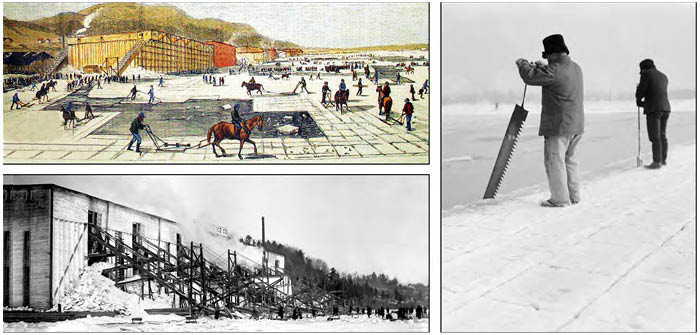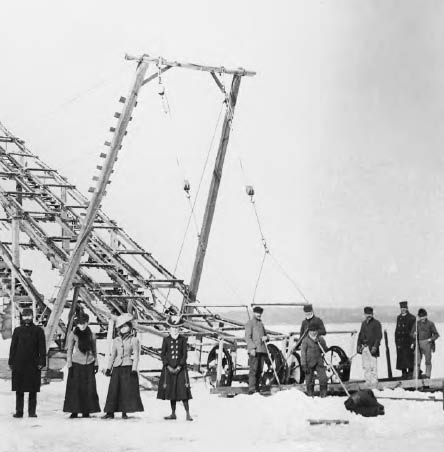
Clockwise from top left: an illustration from Harper’s Weekly in 1894 entitled “Ice Crop on the Hudson”; workers cut thick ice into blocks using wooden hand saws; one of more than a hundred ice houses that dotted the landscape along the Hudson River. (Photos from Library of Congress)
You may remember the phrase “Put it in the icebox” from the old days. Well before electric refrigeration was invented — at which point “Frigidaire” became the catch-all phrase — blocks of ice had to be collected from frozen rivers and lakes. The practice dates back to colonial times and became a thriving industry by the late 19th century.
During the winter, when many industries such as brick, bluestone, tanning, and of course the D&H Canal ground to a halt, ice harvesting became a lucrative alternative for unemployed locals. As many as 20,000 signed up each season for this challenging, dangerous work. Work began in late January or February depending on weather conditions. The ice had to be thick enough (14 to16 inches was ideal), and the Hudson River remained frozen for only a matter of weeks.
Tools were basic at first. Men and horses pulled snow scrapers, saws, and sleighs along the frozen water to cut the ice. Workers used wooden planks and long poles with hooks or prongs at the end to guide the ice “cakes” to conveyor systems — which later evolved into steam-driven equipment — via floating channels. A conveyor transferred the ice into large icehouses for storage.

A horse-drawn Goodsell & Heppner ice wagon delivering blocks of ice to customers in Kingston. (John Matthews Collection)

Blocks of ice were loaded into ice houses using conveyor systems and kept cold with hay or sawdust. (John Matthews Collection)
In 1859 the Knickerbocker Ice Company, which dominated the industry, employed 750 men at 88 cents per day and required 150 horses to fill their facilities with 80,000 tons of ice.
Icehouses relied on the latest 19th-century technology. They were insulated with hay or sawdust and painted white to reflect the sun. They became so ubiquitous along the Hudson that it was said that an icehouse was never out of sight while one was traveling the river.
According to an 1896 New York Times article, there were 145 icehouses between Marlboro and Troy. The majority were located in the upper Hudson Valley between Catskill and Albany, where the water was less salty. The largest was the Mulford Ice House in Glasco.
Railways and barges transported the ice, which was typically cut into 25-, 50-, and 100-pound blocks and delivered by wagons to customers in the summer. The “iceman“ placed them in iceboxes where perishable food could be kept cold. Hudson Valley ice was delivered to residential and commercial locations primarily in New York City but as far away as New Orleans, the Caribbean, and even India.
In 1896, Knickerbocker joined with others to create a monopoly. The price of ice doubled, setting off unrest and demonstrations. Within a few decades, with increasingly polluted water sources and the advent of refrigeration in the 1920s, the ice-harvesting industry slowly melted away.
This article is condensed from a chapter in “The Story of Historic Kingston: A Journey Through the Hudson Valley and Its Connections With New York City,” the authors’ forthcoming book which will be available in December. To see sample pages and for more information about this 450-page book featuring 850 images, please visit
HudsonValleyHistoryAndArt.com.
"industry" - Google News
July 30, 2021 at 06:00PM
https://ift.tt/3fbUyYl
Ice harvesting: An extractive industry that melted away - Hudson Valley One
"industry" - Google News
https://ift.tt/2RrQtUH
https://ift.tt/2zJ3SAW
Bagikan Berita Ini














0 Response to "Ice harvesting: An extractive industry that melted away - Hudson Valley One"
Post a Comment